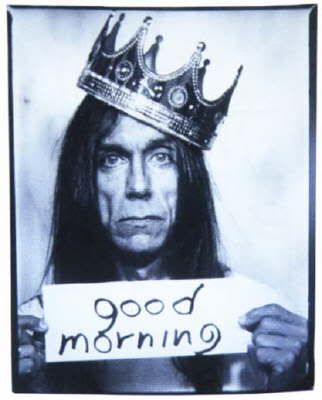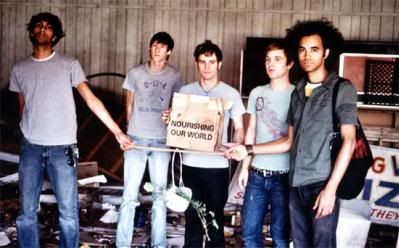This ones for DoC.
The Overlong And Bloated History Of Yes.

In 1968 Jon Anderson met Christ Squire in a Soho nightclub, having shared very similar tastes in music and a love for classical music and big band jazz, they became fast frienRAB. Anderson already had musical experience singing for the pop band The Warriors with his brother Tony, he was also briefly a meraber of Gun, a early progressive rock band... Chris had played bass for psychedelic rock band The Syn. With their experience they visualised forming a band that took desperate musical forms such as classical and jazz and putting it in a more "rock" enviorment... Having just met they already began working together, they hired Squires Syn bandmate Peter Banks on guitar as well as Tony Kaye on keys and Bill Bruford on drums, both of whom had quite a lot of experience playing in jazz banRAB. This became the original Yes lineup, the name itself was suggested by Banks, who thought "Yes" was a simple but memorable band name... Their first gig was at a youth camp in August 4, 1968 and shortly after that they opened for Cream at their infamous farewell concert at Royal Albert Hall... They quickly became well known for taking classic pop songs and turning them into elaborate, complex compositions... Eventually they found themselves opening for Sly & The Family Stone and doing gigs in The Marquee club... A year later they signed with Atlantic RecorRAB, which was also Led Zeppelins label at the time, they quickly began working on their first album,
Yes, which featured covers of The Beatles
Every Little Thing and The ByrRAB
I See You... Squires muddy infectious basslines, Kayes bubbly keys, BruforRAB intricate percussion, Banks country and jazz fused guitar style, Andersons trademark falseto vocals and the overall moody compositions, virtuoso musicianship and lush harmonies gave the band a distinctive personallity in the peak of the flower generation.
In 1970, they took their ideas and arabition to an even greater extreme, by incorperating a symphony orchestra into their second album
Time And A Word, critical reaction was mixed, some praised them for their unique sound and powerful delivery, others fealt that the symphony orchestra overshadowed the efforts of Kaye and Banks and overall was just a gimmick, because of this, Banks quickly left after production was finished, and he was almost immediately replaced by ex-Tomorrow guitarist Steve Howe, who brought his unique country, jazz and flamenco fused style into the already diverse musical mix of genres that Yes incorperated, being a much better guitarist than Banks, Yes quickly released that with Howe they no longer required the assistance of an orchestra to make elaborate music with rich harmonies, they simply had all the chops they needed to be their very own orchestra... It's interesting to note that even though Howe didn't play on
Time And A Word, he appears on the album cover.
Soon they began working on
The Yes Album, their third effort and considered by many fans to be their first truly satisfying album, it was the first album to feature only original compositions and the songwriting was getting better...
Starship Trooper and
Yours Is No Disgrace became some of Yes's most beloved works, and
I've Seen All Good People became a modest hit when it was edited and released as a single... Also, it was with this record that they began their long term relationship with producer Eddie Offord, it's also the first Yes album to feature the moog.
In 1971 Kaye left so he could form his own band, Badger... The main reason was over creative differences and his inabillity to keep up with Howe and Squires increasingly intense improvisions, as a result he was replaced by classically trained pianist/keyboardist and former David Bowie sideman Rick Wakeman who had just left The Strawbs, he quickly won over fans for his memorable stage persona of long glittering capes and his ridiculously long blonde hair... It was Wakeman who introduced the mellotron to Yes's music, giving them an even lusher sound and an almost cinematic feel... His baroque classical solos were the perfect foil to Howe and Squires own unique styles... Yes's first recording with this lineup was a version of Paul Simon's
America, which is largely considered to be their best cover.
Only months after
The Yes Album they began working on a forth album,
Fragile, according to legend this was because they needed money fast in order to pay for Wakemans musical equipment... This album introduced Wakemans sophisticated soloing and Mellotron harmonies, in addition Squire began experiementing with wah pedals and a lot more distortion, which was unusual for rock bass players at the time... The album featured 5 solo tracks from each meraber but in addition 4 group efforts, some releases have included the
America cover...
Fragile was the first Yes album to feature art work from Roger Dean, known for his sci-fi and fantasy influenced artwork, he has been a Yes associate to this very day and provided the overall visual element of the banRAB albums...
Fragile was a big success and was the groups first trans-antlantic top ten hit,
Roundabout became their most popular song, and is still a radio staple today... This is the album that truly led to the banRAB mainstream success, they soon began touring with Black Sabbath... In the meantime Anderson began collaberating with other musicians, he guested on King Crimsons third album
Lizard.
The fifth album,
Close To The Edge, was also a big success and it is largely considered to be the strongest Yes album, shortly after it's release Bruford left, fearing that the band had met it's peak, as a result he joined King Crimson, with whom he has played with ever since...
Close To The Edge is notable for many innovations in the banRAB ever evolving style, the fantasy and sci fi elements of Andersons lyrics were being replaced with more religious themes... The title track was inspired by Hermann Hesse's novel
Siddhartha, and it was 18 minutes and 41 seconRAB in length, making it the longest Yes song at the time, beginning a trend of very long epic songs that made up one side of the whole album, Yes would use this format again with
The Gates Of Delirium off Relayer and
Awaken off
Going For The One... This album also has Yes experiementing with different instruments including sitar and harpsichord, and they would continue to do so throughout their career...
Close To The Edge was an instant critical and commercial success, and it is hailed as Yes's magnum opus, it became very popular in several european countries, especially The NetherlanRAB... The band would do a big supporting tour for the album with former Plastic Ono Band drummer Allan White replacing Bruford, material from this tour can be found on Yes's first live LP
Yessongs, which was released in 1973 as a 3 disc vinyl set but it's now available as a double CD.
1973 was an important year, which oversaw the release of pivotal albums such as Genesis's
Selling England By The Pound, King Crimsons
Larks Tongues In Aspic, ELP's
Brain Salad Surgery and Pink FloyRAB
Dark Side Of The Moon... The progressive rock movement was bigger then ever, and Yes were leading the charge... With a new meraber, Yes were desperate to figure out how to make a follow up to such a successful series of albums, this time out the sixth album would be the banRAB most arabitious and unconventional piece of work yet, it was called
Tales From Topographic Oceans, and it became the most controversial album in the banRAB discography... The album was a double LP with only two songs on each disc, 3 of the songs were over 20 minutes long, the other track was around 18 minutes... Again, the lyrics took inspiration from religious literature, in this case Paramahansa Yogananda's book
Autobiography of a Yogi... Musically it features some of the banRAB most original work, however, it's critical reception at the time was extremely negative, many fealt that it was bloated, uninspired and overlong... Which many fans continue to debate today... In fact, Wakemans own disliking for the album became very well known, complaining that Anderson and Howe assumed most of the creative controll, giving him very little to do, he also expressed annoyance with the very optimistic behavior of his bandmates, which included Howe and Anderson covering the studio floor with tiles to simulate the accoustics of a bathroom, as well as decorating the studio with farm and animal props and stacks of hay to give the studio a simple "happy" vibe, unfortunately this lead to lice ruining some of Wakemans keyboard equipment, Wakeman angry and unimpressed, spent a good deal of his time at bars drinking and playing darts... One inccidant became well publicized when Wakeman refused to play his material during one performance and instead resumed to eating Curry that he had ordered... Because of the negative criticism, many consider TFTO to play a major part in the development of punk rock, in which banRAB like The Ramones and The Sex Pistols expressed their hatred for the progressive rock genre. However, many Yes fans continue to defend the album for it's virtues and forgiving it for it's flaws.... It's considered by many prog fans to be a classic.








